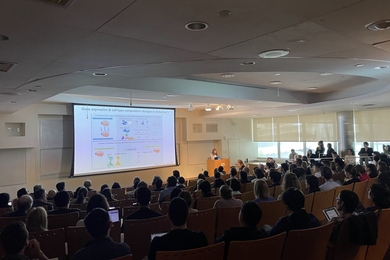In a basement laboratory at MIT, assistant professor of physics Jocelyn Monroe is making some final adjustments to her team's newest particle detector. In just a few months, the detector will be 1,600 feet underground in Carlsbad, N.M., searching for the elusive particles known as dark matter.
Dark matter — considered one of the most baffling mysteries in science — is believed to make up 20 to 25 percent of the universe, while visible matter makes up only four percent. However, dark matter has never been directly observed, and scientists aren't even exactly sure what kind of particles they are looking for.
Scientists theorize the existence of dark matter to explain observations that suggest there is far more mass in the universe than can be seen. Because dark matter does not absorb or emit light, it has thus far proven impossible to detect. "There's a lot of dark matter out there, and nobody knows the best way to look for it," says Monroe.
Identifying dark matter is a fundamental pursuit, says MIT physics professor Peter Fisher, who has been studying dark matter for 20 years. "If you go way back in time, to the Neanderthals sitting around the fire, one of the first questions humans ask themselves is, 'what is the world made of?'" he says.
Dozens of research groups around the world are racing to be the first to detect dark matter. A few have reported possible detections in the past year, but those findings are not widely accepted.
Monroe, Fisher and associate professor Gabriella Sciolla have devised a new way to look for dark matter, taking advantage of the prediction that the particles should approach Earth from a certain direction in space.
'Solid evidence'
Caltech researcher Fritz Zwicky first proposed dark matter in the 1930s as a way to explain discrepancies between the inferred mass and the light output of a cluster of galaxies. Zwicky found that the amount of light coming from stars in the Coma galaxy cluster was about 100 times lower than would be expected from a cluster of its mass.
At first, other physicists assumed the missing mass must be gas or dust, but scientists have since embraced dark matter as a way to explain Zwicky's astronomical observations and others that don't add up. For example, spinning galaxies generate centripetal force that would tear them to shreds if not for the counteraction of gravity. However, there isn't enough visible matter in those galaxies to produce the necessary gravitational pull, so physicists theorize that dark matter makes up the difference.
"There is solid evidence that dark matter exists. What we're missing is direct observation of dark matter," says Sciolla, the Cecil and Ida Green Associate Professor of Physics.
Physicists have devised numerous ways to look for dark matter. Some experiments look for indirect evidence of dark matter by measuring gamma rays emitted when dark matter decays, while others try to capture the distinctive electronic traces that should be left behind when dark matter collides with other particles.
One major difficulty in looking for traces of collisions is that WIMPS (weakly interacting massive particles), one of the theoretical types of particles that scientists believe may make up dark matter, have very weak interactions with normal matter.
"We expect these particles to have interactions with protons and neutrons, but the probability of those interactions is very, very small," says Monroe.
WIMPs normally pass through regular matter without interacting at all. It is estimated that the density of dark matter (if the dark matter particle is 100 times heavier than a proton) is such that there are 10 WIMPs in a two-liter bottle of soda. Fewer than one of these WIMPs will interact with a nucleus in an entire year.
To make things even more difficult, these incredibly rare interactions can be easily overshadowed by neutron collisions, which occur much more frequently and produce a similar signature in the detector. To prevent neutrons from masking potential dark matter detections, physicists install their detectors far underground, in hopes of blocking neutrons hurtling toward Earth from outer space.
Because there are so many other possible events that could masquerade as dark matter interactions, solid evidence will be required for physicists to accept any potential dark matter detection.
"You have to make a convincing argument that you're not seeing something else, and that's very hard," says Fisher.
Dark matter wind
The MIT team's new dark matter detector (Dark Matter Time Projection Chamber) is expected to start running late this year or early next year, and is designed to look for the so-called "dark matter wind."
The disc-shaped Milky Way galaxy rotates through a spherical halo of stationary dark matter. So, just as there seems to be a wind blowing toward you when you stick your arm out the window of a moving car, "there should be an opposing wind of dark matter particles blowing opposite to the direction of our motion, because we're moving and it's not," says Monroe.
This "dark matter wind" approaches Earth from the direction of the constellation Cygnus. Incoming dark matter should collide with fluorine-rich gas inside the new detector and knock off fluorine atoms, which will recoil in the opposite direction.
The researchers can compare the direction of incoming particles with the location of Cygnus, which shifts position relative to Earth every 12 hours (just as the sun appears to set and rise). That should allow them to distinguish dark matter interactions from other electronic traces picked up by the detector.
Monroe is also working on a detector called Mini-CLEAN, which will be housed in an old coalmine about a mile underground in Sudbury, Ontario. The detector, expected to start collecting data late next year, contains 300 kilograms of liquid argon. When dark matter particles collide with an argon nucleus, the nucleus recoils, producing a burst of light.
A second detector, designed to pick up neutron collisions, will be placed next to the dark matter detector. That way, interactions that show up in both detectors can be dismissed, and those appearing only in the dark matter detector can be considered reliable.
How long will it take any of these detectors to pick up dark matter interactions? That depends on chance, as well as the size and sensitivity of the detector. The sensitivity of dark matter detectors has grown by several orders of magnitude since the earliest experiments, 20 years ago, and continues to improve.
However, the lack of results so far has led some physicists, including Fisher, to question whether they're even looking for the right thing. "After a while, there should be some hint, some indication, and there really just isn't anything," he says.
But the search continues, and some are hopeful that the first sighting is not too far off. "Maybe not this year, but I would bet a good bottle of champagne it will be found within the next 10 years," says Monroe.
Dark matter — considered one of the most baffling mysteries in science — is believed to make up 20 to 25 percent of the universe, while visible matter makes up only four percent. However, dark matter has never been directly observed, and scientists aren't even exactly sure what kind of particles they are looking for.
Scientists theorize the existence of dark matter to explain observations that suggest there is far more mass in the universe than can be seen. Because dark matter does not absorb or emit light, it has thus far proven impossible to detect. "There's a lot of dark matter out there, and nobody knows the best way to look for it," says Monroe.
Identifying dark matter is a fundamental pursuit, says MIT physics professor Peter Fisher, who has been studying dark matter for 20 years. "If you go way back in time, to the Neanderthals sitting around the fire, one of the first questions humans ask themselves is, 'what is the world made of?'" he says.
Dozens of research groups around the world are racing to be the first to detect dark matter. A few have reported possible detections in the past year, but those findings are not widely accepted.
Monroe, Fisher and associate professor Gabriella Sciolla have devised a new way to look for dark matter, taking advantage of the prediction that the particles should approach Earth from a certain direction in space.
'Solid evidence'
Caltech researcher Fritz Zwicky first proposed dark matter in the 1930s as a way to explain discrepancies between the inferred mass and the light output of a cluster of galaxies. Zwicky found that the amount of light coming from stars in the Coma galaxy cluster was about 100 times lower than would be expected from a cluster of its mass.
At first, other physicists assumed the missing mass must be gas or dust, but scientists have since embraced dark matter as a way to explain Zwicky's astronomical observations and others that don't add up. For example, spinning galaxies generate centripetal force that would tear them to shreds if not for the counteraction of gravity. However, there isn't enough visible matter in those galaxies to produce the necessary gravitational pull, so physicists theorize that dark matter makes up the difference.
"There is solid evidence that dark matter exists. What we're missing is direct observation of dark matter," says Sciolla, the Cecil and Ida Green Associate Professor of Physics.
Physicists have devised numerous ways to look for dark matter. Some experiments look for indirect evidence of dark matter by measuring gamma rays emitted when dark matter decays, while others try to capture the distinctive electronic traces that should be left behind when dark matter collides with other particles.
One major difficulty in looking for traces of collisions is that WIMPS (weakly interacting massive particles), one of the theoretical types of particles that scientists believe may make up dark matter, have very weak interactions with normal matter.
"We expect these particles to have interactions with protons and neutrons, but the probability of those interactions is very, very small," says Monroe.
WIMPs normally pass through regular matter without interacting at all. It is estimated that the density of dark matter (if the dark matter particle is 100 times heavier than a proton) is such that there are 10 WIMPs in a two-liter bottle of soda. Fewer than one of these WIMPs will interact with a nucleus in an entire year.
To make things even more difficult, these incredibly rare interactions can be easily overshadowed by neutron collisions, which occur much more frequently and produce a similar signature in the detector. To prevent neutrons from masking potential dark matter detections, physicists install their detectors far underground, in hopes of blocking neutrons hurtling toward Earth from outer space.
Because there are so many other possible events that could masquerade as dark matter interactions, solid evidence will be required for physicists to accept any potential dark matter detection.
"You have to make a convincing argument that you're not seeing something else, and that's very hard," says Fisher.
Dark matter wind
The MIT team's new dark matter detector (Dark Matter Time Projection Chamber) is expected to start running late this year or early next year, and is designed to look for the so-called "dark matter wind."
The disc-shaped Milky Way galaxy rotates through a spherical halo of stationary dark matter. So, just as there seems to be a wind blowing toward you when you stick your arm out the window of a moving car, "there should be an opposing wind of dark matter particles blowing opposite to the direction of our motion, because we're moving and it's not," says Monroe.
This "dark matter wind" approaches Earth from the direction of the constellation Cygnus. Incoming dark matter should collide with fluorine-rich gas inside the new detector and knock off fluorine atoms, which will recoil in the opposite direction.
The researchers can compare the direction of incoming particles with the location of Cygnus, which shifts position relative to Earth every 12 hours (just as the sun appears to set and rise). That should allow them to distinguish dark matter interactions from other electronic traces picked up by the detector.
Monroe is also working on a detector called Mini-CLEAN, which will be housed in an old coalmine about a mile underground in Sudbury, Ontario. The detector, expected to start collecting data late next year, contains 300 kilograms of liquid argon. When dark matter particles collide with an argon nucleus, the nucleus recoils, producing a burst of light.
A second detector, designed to pick up neutron collisions, will be placed next to the dark matter detector. That way, interactions that show up in both detectors can be dismissed, and those appearing only in the dark matter detector can be considered reliable.
How long will it take any of these detectors to pick up dark matter interactions? That depends on chance, as well as the size and sensitivity of the detector. The sensitivity of dark matter detectors has grown by several orders of magnitude since the earliest experiments, 20 years ago, and continues to improve.
However, the lack of results so far has led some physicists, including Fisher, to question whether they're even looking for the right thing. "After a while, there should be some hint, some indication, and there really just isn't anything," he says.
But the search continues, and some are hopeful that the first sighting is not too far off. "Maybe not this year, but I would bet a good bottle of champagne it will be found within the next 10 years," says Monroe.






